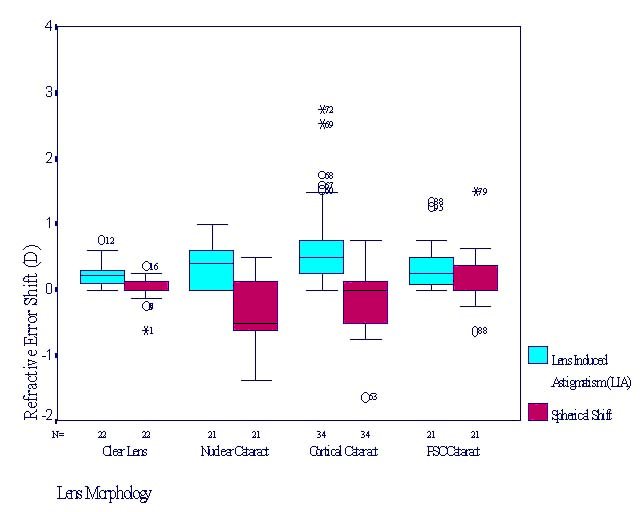Return to Presentations Fort Lauderdale, Florida, ![]()
sponsored by the Association for Research in Vision and Ophthalmology (ARVO)
Extract from Invest Ophthalmol Vis Sci 2002; 43(4):S?
Refractive error changes in cortical, nuclear and posterior subcapsular cataracts
![]()
D.B. Elliott & K. Pesudovs .
Department of Optometry, University of Bradford, Bradford, United Kingdom..
Purpose. To determine the effect of the three main morphological types of age-related cataract on refractive error.
Methods. Ninety-eight elderly subjects (mean age 67 ± 8 years) were recruited. Ocular screening excluded amblyopia, strabismus, eye disease or surgery. Cataracts were classified with the LOCS III system. Optimal refractive correction determined by retinoscopy and subjective refraction. The Jackson cross-cylinder was used to determine astigmatism subjectively. Changes in refractive error were defined as the difference between the optimal refractive correction and that taken from the patientís spectacles. Spherical changes were calculated from the spherical equivalent value (sphere + 1/2 cylinder. Cylindrical changes were determined by vector analysis (Alpins, 2001) which combines the changes in cylinder power and axis. The term lens induced astigmatism (LIA) is coined to express the vector difference between the subjectsí spectacle correction and the optimal refractive correction.
Results. The differences in mean sphere are shown as positive if the optimal refractive correction was more hyperopic (less myopic) than the patientís spectacles and negative if the optimal refractive correction was more myopic (less hyperopic) than the patientís spectacles. Lens induced astigmatism is recorded as positive. Spherical refractive error shift and lens induced astigmatism are shown in the figure below for each of the group of subjects.

Conclusions. Cortical cataract can cause significant astigmatic shifts. Nuclear cataract can cause significant myopic shifts. Posterior subcapsular cataract showed refractive changes similar to an age-matched normal group. There was a slight minus shift in the cortical cataract group. We suggest that this is likely to be caused by slight nuclear cataract (less than grade II LOCS) in some patients in this group. There was a slight astigmatic shift in the nuclear cataract and PSC groups. We suggest that this is likely to be caused by slight cortical cataract (less than grade II LOCS) in some patients in these groups.
![]() Poster contents as PDF (104 Kb)
Poster contents as PDF (104 Kb)